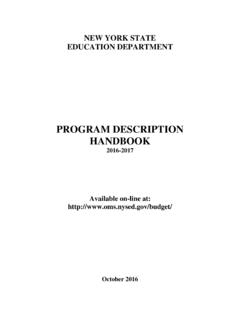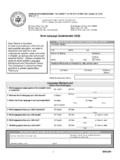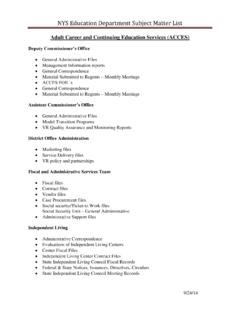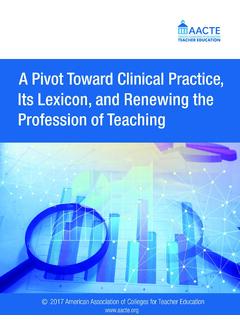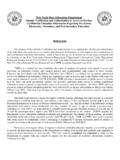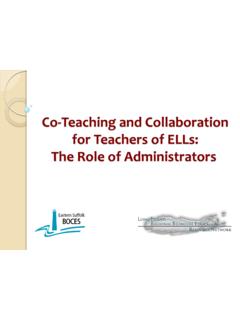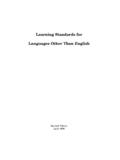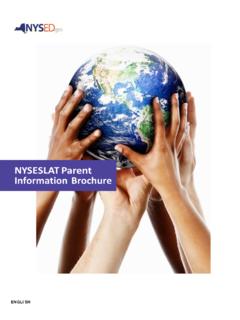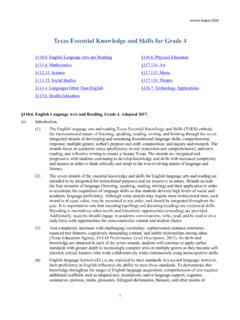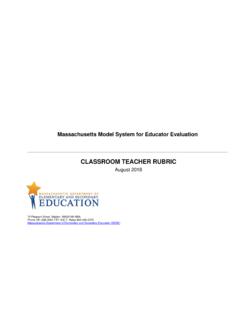Transcription of Introduction New York State Next Generation English ...
1 New York State Education Department English LANGUAGE ARTS LEARNING STANDARDS 1 NEW YORK State EDUCATION DEPARTMENT New York State Next Generation English Language Arts Learning Standards GRADES P-12 Introduction REVISED 2017 New York State Education Department English LANGUAGE ARTS LEARNING STANDARDS Introduction (2017) 2 NEW YORK State EDUCATION DEPARTMENT Introduction to the NYS Standards Design Process In 2015, New York State (NYS) began a process of review and revision of its current English Language Arts (ELA) Learning Standards adopted in January 2011.
2 The New York State Next Generation English Language Arts Learning Standards (Revised 2017) were developed through numerous phases of public comment as well as virtual and face-to-face meetings with committees consisting of NYS educators, teachers of English Language Learners/Multilingual Learners and Students with Disabilities, parents, curriculum specialists, school administrators, college professors, and experts in cognitive research. These revised standards reflect the collaborative efforts and expertise among all constituents involved.
3 The New York State Next Generation English Language Arts Learning Standards (Revised 2017) consist of revisions, additions, deletions, vertical movement, and clarifications of the current English Language Arts Standards. They are defined as the knowledge, skills, and understanding that individuals can and do habitually demonstrate over time when exposed to high-quality instructional environments and learning experiences. Context for Revision of the NYS Next Generation English Language Arts Learning Standards CHANGING EXPECTATION FOR LITERACY ACHIEVEMENT Today s context for English Language Arts instruction and Learning Standards mark an inflection point for NYS and the field of education.
4 Indeed, nationally and across the State , districts are increasingly focused on literacy instruction from the earliest years right through adolescence with the goal of developing models and curricula that support universal literacy achievement, while accommodating two key changes: 1) the new demands for what it means to be literate in today s knowledge-based economy and information age; and 2) the demographic shifts in the population. reading and writing both language-based competencies have become prerequisites for participation in nearly every aspect of day-to-day, 21st-century life.
5 While there was a time when basic literacy skills provided a clear path forward, today s students need to develop an increasingly complex set of literacy skills and competencies in order to access social and economic opportunities. In this knowledge-based economy Advanced Literacy: A Call to Prepare Our Students for Lifelong Learning The rate at which knowledge is generated and shared today, often via technology, is unprecedented in human history. To keep pace, today s children must become tomorrow s lifelong learners, able to marshal reading , writing and thinking skills.
6 Today s children must also become adults who are able to communicate and navigate an increasingly interconnected society one in which literacy skills are routinely called upon. In other words, all students in NYS classrooms must develop advanced literacies. Advanced literacies denote a set of skills and competencies that enable communication, spoken and written, in increasingly diverse ways and with increasingly diverse audiences. This requires writing with precision, reading with understanding and speaking in ways that communicate thinking clearly.
7 Advanced literacies also promote the understanding and use of text for a variety of purposes. Likewise they make way for participation in academic, civic, and professional communities, where knowledge is shared and generated. New York State Education Department English LANGUAGE ARTS LEARNING STANDARDS Introduction (2017) 3 NEW YORK State EDUCATION DEPARTMENT and information-age, what counts as literate has changed dramatically over the last few To be academically and personally successful in today s literacy- and knowledge-based society and economy, every student needs to develop advanced This term denotes skills and competencies that enable communication, spoken and written, in increasingly diverse ways and with increasingly diverse audiences.
8 Advanced literacies also promote the understanding and use of text for a variety of purposes. Likewise they make way for participation in academic, civic, and professional communities, where knowledge is shared and Practices of Readers and Writers: Overview One new aspect in the revised Standards is the inclusion of the Lifelong Practices of Readers and Writers, which aim to reflect the changing expectations for what it means to be literate today. To optimally support this vision for literacy classroom planning, coursework, and instruction based on the ELA standards should develop within the context of the Lifelong Practices of Readers and Writers.
9 Once firmly and richly developed, these practices extend well beyond graduation, as qualities of lifelong learning. These practices are a context for the NYS English Language Arts Learning Standards which, in turn, support these practices by specifying grade level expectations for readers and writers. The chart on the following page outlines some of the most important practices expected of readers and writers. Although there are two lists, these practices are blended. For example, by design, the first bullet under reading intentionally mentions thinking, writing, speaking, and listening.
10 In other words, successful readers employ a complex web of skills in order to become effective communicators who strive to understand the world around them. Similarly, writers use a blend of thinking, reading , speaking, and listening as they strengthen their writing. The practices also indicate that teachers should expect students to read often and widely from a range of and diverse texts , in terms of content, language, origin, medium, and text type. The New York State Education Department remains committed to encouraging local districts to choose the literature and informational texts they use as they design their ELA curriculum or programs.
